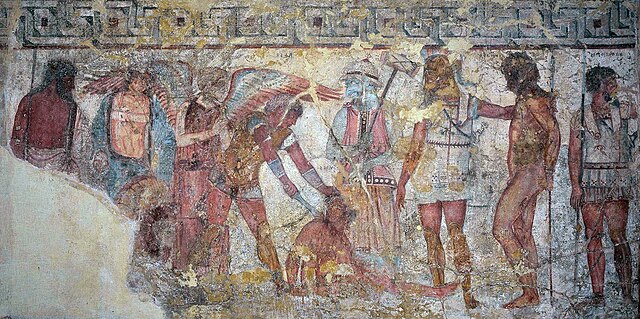George Chapman was an English dramatist, translator and poet. He was a classical scholar whose work shows the influence of Stoicism. William Minto speculated that Chapman is the unnamed Rival Poet of Shakespeare's sonnets. Chapman is seen as an anticipator of the metaphysical poets of the 17th century. He is best remembered for his translations of Homer's Iliad and Odyssey, and the Homeric Batrachomyomachia.
Chapman. Frontispiece engraving for The Whole Works of Homer (1616) attributed to William Hole
Grave marker of Chapman now inside the church of St Giles in the Fields, London. The memorial, in the form of a Roman altar, was designed and paid for by Inigo Jones, and was previously in St Giles' churchyard.
The Iliad is one of two major ancient Greek epic poems attributed to Homer. It is one of the oldest extant works of literature still widely read by modern audiences. As with the Odyssey, the poem is divided into 24 books and was written in dactylic hexameter. It contains 15,693 lines in its most widely accepted version. Set towards the end of the Trojan War, a ten-year siege of the city of Troy by a coalition of Mycenaean Greek states, the poem depicts significant events in the siege's final weeks. In particular, it depicts a fierce quarrel between King Agamemnon and a celebrated warrior, Achilles. It is a central part of the Epic Cycle. The Iliad is often regarded as the first substantial piece of European literature.
Inscription of lines 468–473, Book I. 400–500 AD, from Egypt. On display at the British Museum
Iliad, Book VIII, lines 245–253, Greek manuscript, late 5th, early 6th centuries AD
Thetis at Hephaestus' forge waiting to receive Achilles' new weapons. Fresco from Pompeii, 1st century
A detail of fresco from the François Tomb at Vulci, showing the sacrifice of Trojan slaves. From left to right: Agamemnon, ghost of Patroclus, Vanth, Achilles beheading a slave, Charun, Ajax the Great, a slave, Ajax the Lesser. 350-330 BC






